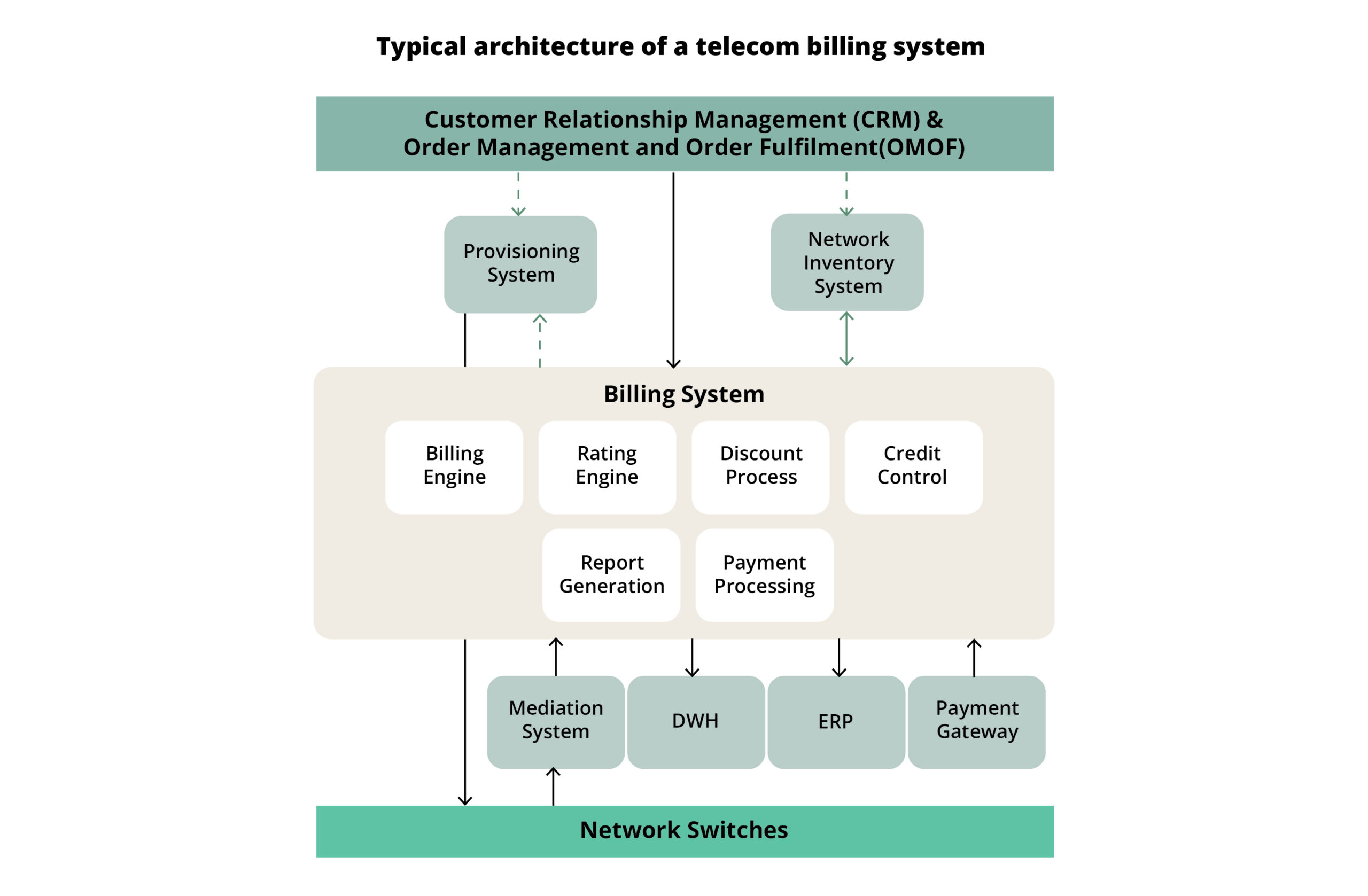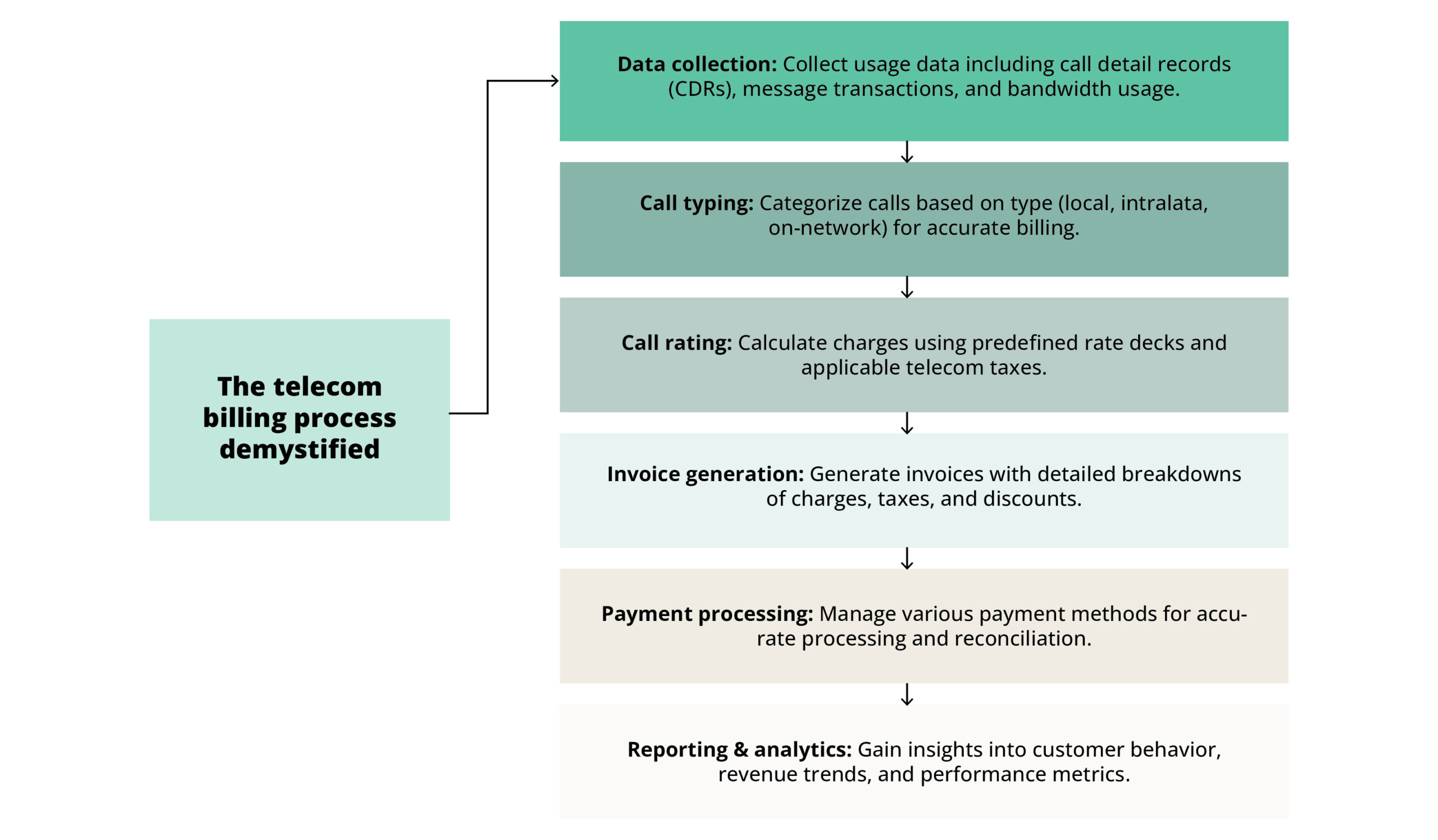Once associated with the back office, telecom billing systems have undergone a remarkable transformation. A sophisticated telecom billing platform tackles challenges head-on, providing telecommunications companies with an innovative, user-friendly, and automated solution. Modern telecom billing systems are more than telco payment services and invoice processing tools. Now, telecom billing tools harness a combination of automation, self-service features, big data analytics, and real-time usage and billing insights to offer revolutionary capabilities.
In this article, we explore types of telecom billing, how telecom billing solutions work, and what new technologies and trends can offer telecommunications providers. We also share insights from our hands-on experience, from real-time charging and personalized billing options to predictive analytics and revenue optimization. Explore all of them now!
Understanding the basics: What is a telecom billing system?
Billing systems in telecom are designed to handle the intricate processes, data management, and contractual policies necessary for telecom companies to generate accurate customer invoices. Unlike businesses in other industries, telecoms face complex billing processes due to the multitude of data and contractual terms involved in each billing cycle.
Telecommunications billing systems must precisely calculate network usage data, guaranteeing accuracy across provisioning, billing, usage, and rating. Telecom billing systems process various usage records, such as Call Detail Records (CDR) and network traffic measurements, along with managing pricing, taxes, tariffs, and discounts for network usage, including cloud computing elements.
Telcos must efficiently handle pricing models, billing configurations, audit settings, billing delivery channels, billing cycle schedules, and event triggers. Telecom billing also manages payment functions such as tracking, processing, consolidation, and correspondence between payments.
Telecoms employ online charging systems (OCS) that link payments and network transactions to control telecommunications network access based on a customer’s account balance.

Billing systems in telecom are designed to handle the intricate processes, data management, and contractual policies necessary for telecom companies to generate accurate customer invoices.
Source: https://www.tutorialspoint.com/telecom-billing/system-architecture.htm
In essence, a telecom billing system is a comprehensive software solution managing the processes, data, and contractual elements necessary to invoice for and generate revenue from providing telecommunications services. These systems cover financial, information, and operational management, including fraud management, profitability management, and revenue assurance:
- Financial management aspects of telecom billing systems encompass payment tracking and processing, tax calculation, credit allocation, debt collection management, and reconciliation of payments with service usage.
- Information management involves integrating with customer relationship management (CRM) solutions to oversee customer information, product data, pricing models, billing cycles, and delivery channels.
- Operationally, a telecom billing system captures usage data; accurately applies prices, tariffs, discounts, charges, and taxes to each customer account; generates invoices; applies adjustments; and maintains detailed account records.
Types of billing in the telecom industry: From retail to wholesale
Telecommunications billing encompasses a variety of financial activities and customer invoicing procedures. Telecom billing management involves tasks such as gathering and analyzing call detail records (CDRs) to determine charges according to rate plans and tariffs. As a result, telecom billing software generates invoices, processes payments, ensures revenue accuracy (for example, by addressing unpaid or overdue bills and reconciling financial records), and seamlessly integrates with CRMs and other relevant systems.
There are five major categories of telecom billing:
- Retail billing
- Real-time billing
- Convergent billing
- Wholesale billing
- Multi-tenant MVNE (mobile virtual network enabler) billing
The table below highlights the distinctive features and focuses of each type of telecom billing:
| Type of telecom billing | Definition | Focus |
|---|---|---|
| Retail billing | Invoices individual consumers for services like mobile phone plans, internet subscriptions, and pay-per-view content based on individual usage | Focuses on individual customer billing, ensuring accuracy and transparency in invoicing for various services |
| Real-time billing | Charges customers for their usage in real time or near real time, allowing for immediate deduction of funds from their account balance | Focuses on providing immediate billing updates and allowing customers to monitor their usage and real-time expenses |
| Convergent billing | Charges customers for multiple services on a single invoice, combining various telecom services (mobile, fixed-line, internet, TV) in one billing account | Focuses on streamlining billing processes and offering bundled services, enhancing convenience and cost-effectiveness for customers |
| Wholesale billing | Invoices other telecom providers or resellers for use of network infrastructure, such as leased lines or bulk voice and data services | Focuses on invoicing and monetizing network infrastructure usage, providing a revenue stream for telecom operators |
| Multi-tenant MVNE billing | Enables MVNOs to offer telecom services without owning network infrastructure, allowing for custom pricing plans and billing for sub-brands | Focuses on providing MVNOs with a scalable and customizable billing solution tailored to their specific needs, ensuring revenue |
How does a telecom billing solution work?
Telecom billing is a vital aspect of telecommunications service providers, encompassing steps from collecting usage data to generating customer invoices and processing payments:

1. Data collection and call typing
At the core of the telecom billing cycle is collection of usage data, including call detail records (CDRs), message transactions, and bandwidth usage. These data serves as the foundation for billing, with each call meticulously categorized based on its type (such as local, IntraLATA, or on-network) to facilitate accurate billing.
2. Call rating and charge calculation
Following data collection, the billing system rates each call, calculating charges based on predefined rate decks and applicable telecom taxes. While matching originating phone numbers from CDRs with customer data, the system determines pricing and applies charges to ensure customers are billed accurately for their service usage.
3. Billing and invoice generation
Once call ratings are finalized, the billing system generates invoices, calculates fees, rounds decimal places, and applies discounts or free minutes as necessary. The resulting invoice details a customer’s recurring and non-recurring charges, taxes, and discounts for the billing period.
4. Invoice formatting and transmission
Invoices are formatted with relevant customer information, service details, and billing charges, often including custom messaging, promotions, or announcements to enhance customer understanding. These invoices are then transmitted to customers via email, print, or PDF format, with convenient online access through customer portals.
5. Payment processing and customer self-service
The billing system ensures accurate payment processing and reconciliation by managing various payment methods, including cash, automated payments, credit cards, and ACH transactions. Customers can access self-service portals to manage their accounts, submit payments, and receive support, offering flexibility and convenience in managing their telecom services.
6. Reporting and analytics
Leveraging reporting and analytics tools, telecom providers gain insights into customer behavior, revenue trends, and performance metrics. Analyzing billing data allows providers to identify opportunities for revenue growth, service optimization, and customer retention strategies, driving business decisions and operational efficiency.
Challenges telecom billing systems solve
Managing telecom billing in today’s dynamic industry is no small feat. The telecommunications sector faces many challenges, from maintaining billing accuracy to swiftly addressing disputes. Let’s examine the major obstacles encountered in telecom billing management and discover actionable solutions to conquer them.

Handling customer data and payments efficiently
The telecom industry serves many customers worldwide, leading to the challenge of securely managing their data. Telecom billing software offers advanced tools to securely and efficiently handle large volumes of customer data. These solutions also automate payment reminders and provide personalized discounts based on transaction history.
Streamlining subscription management
Monthly subscriptions are a standard billing model in telecom companies, requiring prompt bill preparation and invoice generation at the end of each month. Telecom billing systems streamline this process by quickly generating invoices, enabling timely billing and reducing delays in payment collection.
Preventing cash flow delays due to late payments
Late payments often result from invoice delivery delays, disrupting a telecom business’s cash flow. Advanced billing solutions address this issue by automating invoice generation and delivery, giving customers ample time to settle their accounts. Such a proactive approach strengthens customer relationships and ensures a steady cash flow.
Ensuring consistent billing and customer satisfaction
Inconsistent billing practices can lead to dissatisfied customers and high attrition rates. Telecom billing software generates accurate invoices and delivers them promptly. By adopting professional invoicing practices, telecom companies enhance their reputation and foster positive customer experiences.
Resolving invoice discrepancies and disputes
Invoice discrepancies and disputes can strain customer relationships and impact revenue streams. Modern billing software systems analyze customer usage data and package details to generate accurate invoices, minimizing errors and conflicts. This proactive approach fosters trust and transparency with customers.
Integrating with CRM and ERP tools for efficiency
Integration with CRM and ERP tools enhances the efficiency of telecom billing processes. Advanced billing software seamlessly integrates with existing systems, streamlining operations and facilitating data exchange. This integration optimizes resource allocation and improves overall business performance.
Customizing invoices to meet business and tax requirements
Differences in customer packages and tax obligations necessitate customized billing solutions. Modern billing software offers flexible customization options to adapt to specific business and tax requirements. Telecom companies enhance billing accuracy and compliance by tailoring invoices to individual customer needs.
Ensuring customer data security
Protecting customer banking details is paramount for telecom businesses to maintain trust and credibility. Secure billing software systems leverage advanced encryption and security protocols to safeguard customer data. By prioritizing data security, telecom companies uphold their ethical and professional obligations, strengthening customer trust and loyalty.
9 essential features for telecom billing software
Navigating the complexities of telecom billing management requires robust software equipped with essential features. Let’s explore the key functionalities that drive efficiency and effectiveness in telecom billing systems.

1. Customization to meet company needs
Telecom companies have unique processes and requirements. Customizable billing software allows for workflow adaptation, subscriber management, and inventory tracking to align with the specific needs of each telecom provider. This ensures that software seamlessly integrates into the company’s existing infrastructure and operations.
2. Data security
In an era when data breaches pose significant risks, ensuring the security of sensitive client information is paramount. Advanced encryption protocols within billing software protect customer data from unauthorized access or cyber threats. Additionally, regular data backups provide an added layer of security by safeguarding against data loss due to unforeseen circumstances.
3. Error-free billing
Billing inaccuracies can lead to financial losses and erode customer trust. To mitigate this risk, billing software employs robust algorithms and validation checks to generate accurate invoices. By automating the billing process and minimizing manual intervention, the software reduces the likelihood of errors and discrepancies in billing statements.
4. Timely subscription management
Telecom companies often rely on recurring subscriptions to generate revenue. Efficient billing software streamlines the management of subscription plans, automating the billing cycle and ensuring timely invoice generation. This enables telecom providers to maintain a consistent cash flow and deliver uninterrupted services to subscribers.
5. Payment gateway integration
To offer customers convenient payment options, billing software integrates seamlessly with various payment gateways. This allows subscribers to settle their bills online by credit card, bank transfer, or another preferred payment method. By facilitating quick and secure transactions, integrated payment gateways enhance the customer experience and streamline revenue collection for telecom companies.
6. CRM & ERP integration
Billing software that integrates with existing customer relationship management (CRM) and enterprise resource planning (ERP) systems enhances operational efficiency. By syncing customer data, billing information, and financial records across platforms, integrated software provides a unified view of customer interactions and financial transactions. This enables telecom companies to streamline workflows, improve decision-making, and deliver personalized services to customers.
7. Handling multiple clients and payments
Telecom companies often manage large volumes of customer data and process multiple payments simultaneously. Advanced billing software is equipped to handle these tasks efficiently, offering robust database management capabilities and secure payment processing functionalities. By automating routine tasks and optimizing resource allocation, the software ensures seamless operations even with a high volume of clients and transactions.
8. Support for all business models
Telecom providers operate under diverse business models, including post-paid, pre-paid, and hybrid billing structures. Flexible billing software accommodates these varying models, allowing companies to customize billing plans, tariffs, and pricing structures based on customer preferences and market demands. Additionally, the convergence of billing solutions enables telecom companies to consolidate charges for multiple services into a single invoice, simplifying billing for customers and improving operational efficiency.
9. Detailed billing data provision
Providing customers with transparent and detailed billing data empowers them to monitor their usage, track expenses, and make informed decisions about their telecom services. Billing software generates comprehensive billing reports that include detailed breakdowns of call durations, messaging statistics, data usage, and associated costs. Accessible through online portals or customer accounts, these reports enhance transparency, foster trust, and improve the overall customer experience.
Advanced modules to improve your telecom billing software
With a keen understanding of the complexities of modern telecom billing, Intellias has collaborated with industry leaders to develop innovative features that cater to the diverse needs of telecom operators and subscribers alike. From real-time billing capabilities to personalized billing experiences and seamless integration with existing systems, these advanced features represent a paradigm shift in how telecom billing is perceived and executed.

Innovating revenue streams with real-time billing
The relentless pace of innovation in 5G, IoT, and cloud technologies has demanded modernization of telecom providers’ traditional billing systems. Intellias collaborated with a significant Eastern European telecom operator to design billing infrastructure that could keep up with the digital era. The objective was clear: transitioning from legacy processes to a system prioritizing real-time engagement, operational efficiency, and revenue opportunities.
Intellias brought deep technical expertise and functional insights to the project, focusing on critical areas such as billing estimations, subscription management, pricing mechanisms, and system resilience. Our team ensured data integrity and operational reliability, laying the groundwork for a modern billing system that can adapt to evolving market needs.
Transforming billing into a strategic business tool
Intellias was pivotal in developing a state-of-the-art bill presentation platform that significantly enhanced customer engagement. Key components of the solution include unified bill presentation, contextual personalization, real-time insights for high-value customers, and operational efficiency through a streamlined dashboard for billing operations.
Using cloud-based SaaS solutions, we introduced a flexible and robust platform for bill presentation, ensuring rapid deployment, ease of management, and seamless integration with existing customer portals. This platform features a bill designer with behavioral science-based templates, enabling our client to create engaging bills without requiring design expertise.
Telecom billing solutions: Ready-made vs custom
Providers often face the dilemma of choosing between ready-made and custom options. While ready-made solutions offer convenience and quick implementation, custom solutions provide tailored features to meet specific business needs. Let’s explore the key differences between these approaches and understand which best fits your telecom billing requirements. The table below highlights significant differences between the options related to flexibility, cost, scalability, integration, security, time to deployment, and support.
| Feature | Ready-made solution | Custom solution |
|---|---|---|
| Flexibility | Limited customizability due to predefined features and functionalities | Highly customizable to fit specific business needs and requirements |
| Time to deployment | Quick deployment as the solution is readily available off the shelf | Longer deployment time due to the need for development and customization |
| Cost | Generally lower upfront costs but may incur higher long-term costs for additional features or scalability | Higher upfront costs for development and implementation but potentially lower long-term costs as it can be tailored to exact needs |
| Scalability | Limited scalability as it may not efficiently accommodate future growth or changes in business requirements | Highly scalable to adapt to business growth and changing needs over time |
| Integration | Limited ability to integrate with existing systems and third-party applications | Seamless integration with existing systems, databases, and third-party tools for a cohesive ecosystem |
| Support and maintenance | Standard support and maintenance provided by the vendor may not always meet specific requirements | Customized support and maintenance services tailored to the unique needs of the telecom provider |
| Features and functionality | Predetermined set of features and functionalities may not fully meet the telecom provider’s unique requirements | Custom-built features and functionalities designed to address specific challenges and optimize workflows |
| Control and ownership | Limited control and ownership over the software as it is managed by the vendor | Full control and ownership over the software, allowing for greater autonomy and customization |
| Security | Standard security measures provided by the vendor may not fully meet the telecom providers’ stringent security requirements | Enhanced security measures implemented according to the telecom provider’s specific security policies and regulations |
| User experience | User experience may vary depending on the solution’s readiness and usability | User experience can be optimized for specific needs and preferences of the telecom provider and end users |
Ready to redefine telecom billing?
Today’s telecom billing solutions are more than just tools for invoicing; they embody innovation, automation, and real-time insights, catering to the demands of telecommunications companies and their customers. As explored in this comprehensive guide, modern billing systems leverage advanced technologies such as automation, self-service features, big data analytics, and real-time usage insights to revolutionize how telecom services are monetized and managed.
Ready to embark on your journey to modernize telecom billing for your organization? Contact the Intellias team today to discover how our expertise can transform your billing processes.




